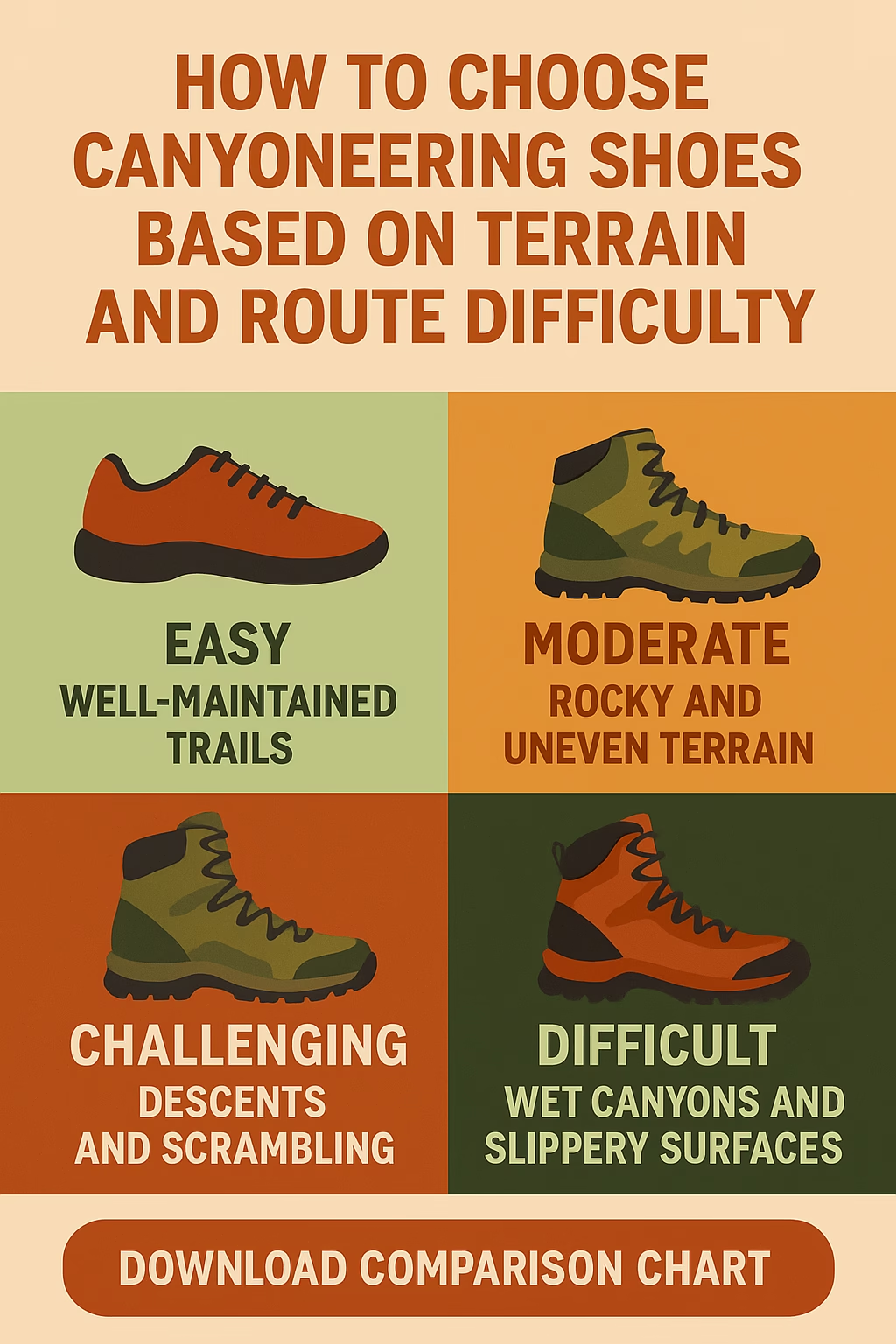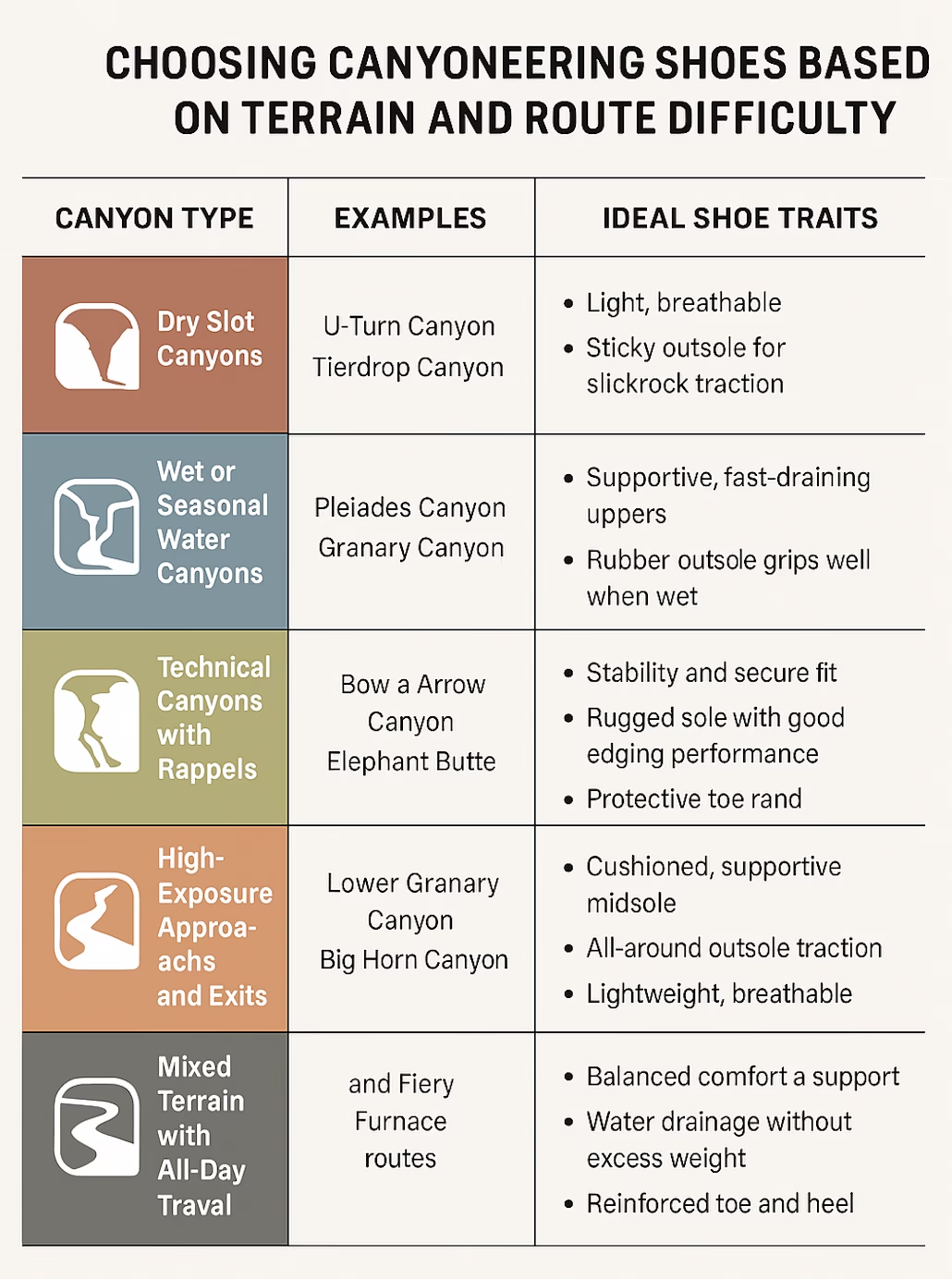
Introduction
When it comes to canyoneering in Moab, your footwear is not just a piece of gear. It is a survival tool, a performance booster, and a comfort system all in one. Choosing the right canyoneering shoe can mean the difference between a smooth, confident adventure and a long, painful day filled with blisters, slips, and soaked socks.
Unlike hiking, where most shoes are built for predictable trails, canyoneering involves navigating through slickrock slopes, icy potholes, wet narrows, technical rappels, and abrasive sandstone corridors. Moab’s canyons present a wide variety of conditions, and not every shoe fits every situation.
This guide will walk you through how to match your shoes to the type of canyon you are planning to explore. Whether your tour involves dry slots, technical descents, or water-filled corridors, this breakdown will help you step into the right pair.
Why Your Shoe Choice Matters in Moab’s Canyons
Footwear might seem like a simple decision, but in Moab, it is one of the most important gear choices you can make. Moab’s desert landscape presents specific challenges such as:
- Smooth sandstone that becomes dangerously slick when wet
- Pools of water or full-body swims depending on the season
- Loose rock and gravel that test your shoe’s stability
- Long approach hikes across exposed terrain
- Technical maneuvers like stemming, chimneying, and rappelling
Canyoneering shoes are engineered for all of this. They offer superior grip, durable construction, excellent drainage, and reinforced protection around your toes and heels. But within the category of canyoneering shoes, there is no one-size-fits-all solution. The ideal shoe for a short, dry canyon is not the same as the one you would wear for a technical, water-filled descent with multiple rappels.
Terrain Categories in Moab Canyoneering
To understand which shoe is right for your adventure, it is essential to understand the terrain types you will encounter. Most Moab routes fall into one or more of these categories:
- Dry Slot Canyons
- Wet or Seasonal Water Canyons
- Technical Canyons with Rappels
- High-Exposure Approaches and Exits
- Mixed Terrain with All-Day Travel
Let us examine each type and break down the footwear features that make sense for each environment.
1. Dry Slot Canyons
Examples: U-Turn Canyon, Tierdrop Canyon, Not Tierdrop
Dry slots are often beginner-friendly and short in duration, with no water exposure. They typically involve scrambling, downclimbs, and narrow passages through sandstone. Grip and precision are key in this terrain.
Ideal Shoe Traits:
- Sticky rubber outsole with a flat tread pattern for slickrock traction
- Lightweight construction to allow fast movement
- Reinforced toe box for protection in tight spaces
- Breathable materials since there is no water to contend with
- Flexible midsole for comfort on short approaches and descents
What to Avoid: Bulky, water-specific shoes that hold unnecessary weight
🧗 Shoe Selection Tip: Prioritize precision and comfort for fast, dry travel through sculpted sandstone.
2. Wet or Seasonal Water Canyons
Examples: Pleiades Canyon, Professor Creek, Granary Canyon (seasonal)
These routes involve wading, swimming, or frequent immersion in pools and waterfalls. Cold water is common in spring and fall, and moisture management becomes the top priority.
Ideal Shoe Traits:
- Aggressive drainage system with mesh panels or port holes
- Fast-drying synthetic uppers that resist water absorption
- Supportive midsole that holds shape even when soaked
- Rubber compounds that maintain grip underwater and on wet rock
- Compatibility with neoprene socks or booties for thermal protection
What to Avoid: Shoes made from absorbent materials or leather that retain water
🌊 Shoe Selection Tip: Fit your shoes with the same neoprene socks you will wear in the canyon to ensure proper sizing and prevent slippage inside the shoe.
3. Technical Canyons with Rappels
Examples: Bow and Arrow Canyon, Cable Arch Canyon, Elephant Butte
These canyons require ropes, harnesses, and often feature long rappels down vertical drops. Footwear must be secure, stable, and rugged enough to protect your feet during transitions and hard landings.
Ideal Shoe Traits:
- Firm heel cup and structured midsole for stability during rope work
- Thick rubber toe and sidewall protection for impact resistance
- Sticky rubber sole for confident starts and landings
- Lacing system that stays secure during rappels and does not loosen easily
- High ankle support if you prefer extra protection during rappels
What to Avoid: Minimalist shoes that do not support technical movements
⛰️ Shoe Selection Tip: Look for shoes with climbing shoe-like grip combined with backpacking-boot support.
4. High-Exposure Approaches and Exits
Examples: Lower Granary Canyon, Big Horn Canyon, some remote Fiery Furnace routes
These canyons involve long hikes to the drop-in and steep climbs on the way out. You might spend as much time hiking as you do in the canyon itself. Comfort becomes critical.
Ideal Shoe Traits:
- Cushioned and supportive midsole to reduce fatigue
- Outsole that grips on both loose soil and slickrock
- Breathable, lightweight construction for extended wear
- Good arch support and shock absorption
What to Avoid: Stiff shoes that feel like mountaineering boots or shoes with poor ventilation
🥾 Shoe Selection Tip: Break your shoes in on a long hike before using them in the canyon to avoid surprises.
5. Mixed Terrain with All-Day Travel
Examples: Multi-canyon tours, remote traverses, guided full-day adventures
You might cross dry sections, rappel into wet chambers, climb out on sandstone ridges, and hike back under the sun. Your shoe needs to do everything reasonably well without failing in any one category.
Ideal Shoe Traits:
- Balanced midsole that provides support without stiffness
- Water drainage without compromising comfort on dry ground
- Reinforced toe and heel protection
- A rubber sole that performs on various surfaces
- Fit that reduces friction over long distances
What to Avoid: Niche shoes that are only good in one condition
🎒 Shoe Selection Tip: If you can only bring one pair of canyoneering shoes for your Moab trip, choose a versatile model that balances performance across wet and dry conditions.
Additional Fit and Function Considerations
Once you choose a shoe based on terrain, dial in the fit. Here is how to get it right.
- Fit with socks: If you plan to wear wool socks or neoprene socks, try your shoes on with those.
- Toe box room: Your toes should have space to wiggle but not enough to slide.
- Heel security: Your heel should not lift or rub when you walk uphill.
- Break-in period: Wear your new shoes on short hikes or stairs before your canyoneering trip.
- Check drainage performance: Hose them down to see how fast they drain and dry.
Downloadable Canyoneering Tour and Footwear Chart
📥 Download the Moab Canyon Tour and Footwear Comparison Chart (PDF)
This free, printable chart helps you match your footwear to popular Moab canyons. It includes:
- Route names and estimated duration
- Water exposure level (dry, seasonal, wet)
- Technical difficulty (beginner, intermediate, advanced)
- Recommended shoe features for each tour
- Compatibility tips for socks and insulation
This tool is perfect for planning your trip, buying the right gear, or packing light with confidence.
Conclusion
Canyoneering is a demanding sport, and in Moab, conditions can change canyon to canyon and even season to season. There is no universal shoe that fits every adventure, but by understanding the relationship between terrain type and footwear function, you can make smart choices that keep you safe and comfortable.
Whether you are stepping into your first dry slot or navigating a rope-heavy, water-filled descent, your shoes will be your most trusted tool. Use this guide and the downloadable chart to make sure you are ready for whatever route you choose.
Need Help Choosing a Route?
Explore our Canyoneering Tours Page to compare trip durations, guide services, and route descriptions—all optimized for your skill level and gear preferences.

